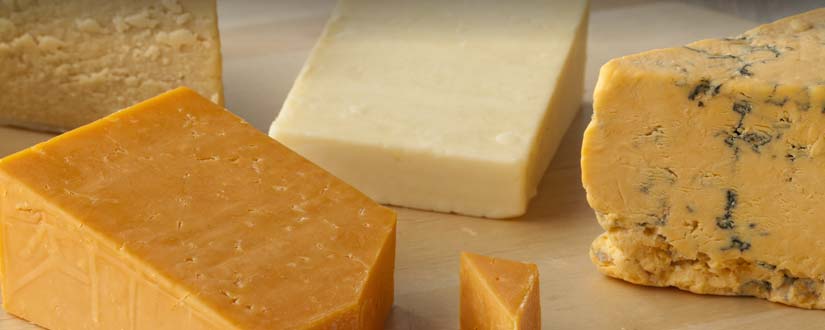…and then through years of know-how your favourite yogurt, cheese, butter and cream are made.
Without a doubt, British consumers love the taste and versatility of dairy foods. Whether it’s milk in your tea, cheese in your sandwich, on your pizza or in a pie, yogurt or cream on your fruit or even butter melting into your toast as you spread it, dairy tastes great.
Have you ever wondered how dairy products are made? If you have, keep reading.
Milk
The milk in your fridge is naturally nutritious and getting it there safely is of the utmost importance to dairy processors.
Milk is collected in tankers by dairy processors every day. The milk is taken to the processing plant where it’s pumped into large vats and undergoes a process called pasteurisation. Pasteurisation is the name given to a process where the milk is quickly heated and cooled again to destroy any harmful bacteria or micro-organisms.
Most milk is also homogenised. All homogenisation does is to break up the fat globules in milk so that it mixes and doesn’t separate and rise to the top. Homogenisation is done by passing milk under pressure through very fine nozzles which evenly disperse the fat globules.
Milk is also standardised, so that your whole milk, semi-skimmed and skimmed milks have the right amount of fat in them. This is done by removing the cream and then adding it back in, in precise amounts, to make whole milk (3.5% fat or more), semi-skimmed (1.5-1.8% fat) and skimmed milk (up to 0.3% fat).
Some brands also offer a 1%-fat milk and a rich Channel Island milk, which comes from Jersey and Guernsey cows, containing 5% fat that has a visible cream line. Others offer milk that is not homogenised.
Organic milk comes from organic farms, which must be registered and regularly inspected by an organic certifier.
Other popular milk types include filtered which extends the shelf life of the milk, Ultra Heat Temperature (UHT) milk that has been heated above pasteurisation levels, and flavoured milks.
Whichever type of milk you choose, it will not only taste great but also contain a rich array of nutrients.
Note on Raw Milk. Raw drinking milk is, as the name suggests, completely untreated and can contain harmful bacteria. For that reason its sale is heavily restricted throughout the UK, and banned altogether in Scotland. Dairy UK does not recommend the consumption of raw drinking milk.
For more information on the nutritional benefits of milk, visit www.milk.co.uk
Cheese
We have been enjoying cheese for centuries across the British Isles and many other parts of the world. Cheshire cheese even gets a mention in the Domesday Book of 1086.
Cheese is still one of the nation’s favourite foods today, with 94% of UK adults tucking in. Around half of cheese sales are Cheddar.
Though it is a simple food, often containing just milk, salt, good bacteria and rennet, there are over 700 named cheeses in the UK.
All cheeses are made from milk by adding a starter culture of bacteria to sour it. Rennet is then added to thicken the milk into curds, which are left to set.
Next, the curds are cut to release the liquid whey. A soft cheese contains more moisture, so the curds are cut less, whereas a hard cheese is finely diced to drain as much whey as possible.
The drained curds are then milled with salt, which acts as a preservative, and usually pressed into a mould to ripen over time. Tight control of the temperature and humidity gives the final delicious result.
Cheese is not only tasty, but comes with a host of nutritional benefits. Hard cheeses are a source of calcium, which is important for maintaining healthy teeth and bones. For more information on the nutritional benefits of cheese head to www.milk.co.uk
Yogurt
Humans have been eating yogurt for thousands of years, although its precise origins are unclear.
It is hugely popular today, with 78% of adults in the UK eating yogurt or fromage frais, and 51% enjoying it more than twice a week. Part of the attraction can be its inherent versatility, as yogurt lends itself well as breakfast food, a snack, dip, dessert or even a drink.
Like milk, yogurt is rich in nutrients important for good health, with a 150g pot of low-fat yogurt offering protein, calcium, B vitamins, iodine, phosphorus and potassium.
There is some evidence that yogurt is also good for people who struggle to digest lactose, because its harmless bacteria have already broken down some of the lactose present.
Yogurt is made with pasteurised milk that has gone through a process called homogenisation to distribute the fat (cream) evenly throughout. This is what makes it so smooth and creamy.
The milk is then kept warm and harmless bacteria are added, which turn the milk’s sugar (lactose) into lactic acid. This in turn thickens the milk and gives it its characteristic tangy flavour.
Once the yogurt reaches the right acidity level, it is cooled and any fruit or flavourings are added. The harmless bacteria usually remain, which is why yogurts are often described as ‘live’ or ‘active’.
There are lots of different varieties of this popular staple, from plain to those flavoured with fruit, honey and even cereals.
Low fat yogurts have no more than 3g of fat per 100g, while fat-free yogurts must be less than 0.5% fat. If a yogurt is described as ‘light’ then it has to contain 30% less fat than similar products.
Greek-style yogurt, Skyr and labneh are concentrated yogurts where the protein content has been raised, usually to 5g or more.
Butter
Butter is made by churning cream. This process makes the fat in the cream collect together so that when the excess liquid (known as buttermilk) is drained off, butter is left over.
The cream used for butter making is heat-treated to kill any harmful bacteria before being cooled again and churned.
There are many types of butter from salted to unsalted, to butter oil to butter concentrate, and dairy blends.
Cream
Ah! the luxurious taste of fresh cream. Rich by tradition and reputation, fresh cream brings richness to soups, dressings, sauces and cakes. Your scone just wouldn’t be the same without it.
Cream is made by separating the butterfat layer from milk before the milk is homogenised.
Delicious and versatile in its own right, cream is also often transformed into other foods, such as ice-cream.
Cream is made by separating the fat from milk before it’s homogenised. Like milk, cream exists in various types. Single cream contains around 18% fat or more, and behaves a lot like milk when you cook with it.
Whipping cream is thicker, allowing it to trap air when beaten, while double cream is thicker still. Clotted cream is the thickest of all, made by baking double cream until a delicious crust forms.
Soured cream is cream which has been fermented, often with the addition of lactic acid for a tangy taste. Crème fraiche is soured cream containing 25% fat or more.
Always check the use by date, keep it in the fridge and keep it covered after opening. Cream needs to be covered as it is susceptible to flavour absorption. The shelf life of cream will be reduced if left out for extended periods. Cream can also be frozen.








